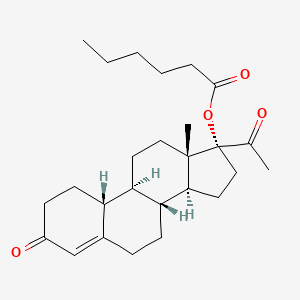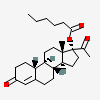Gestonorone Caproate
- gestonorone caproate
- Gestonorone capronate
- 1253-28-7
- Gestronol hexanoate
- Depostat
- Create:2005-06-24
- Modify:2025-01-18

- Caproate, Gestonorone
- Depostat
- Gestonorone Caproate
- Gestronol
- Gestronol Hexanoate
- Hexanoate, Gestronol
- Primostat
- gestonorone caproate
- Gestonorone capronate
- 1253-28-7
- Gestronol hexanoate
- Depostat
- Gestronol caproate
- Primostat
- Caproate de gestonorone
- Caproato de gestonorona
- SH 582
- Gestonoroni caproas
- GESTONORONE HEXANOATE
- Depostat (TN)
- CCRIS 6524
- SH 80582
- 17-Hydroxy-19-norpregn-4-ene-3,20-dione hexanoate
- Gestonoroni caproas [INN-Latin]
- 19-Norprogesterone, 17-hydroxy-, hexanoate
- U38E620NS6
- EINECS 215-010-2
- NSC 84054
- NSC-84054
- SH-582
- Caproate de gestonorone [INN-French]
- Gestonorone caproate [USAN:INN:JAN]
- Caproato de gestonorona [INN-Spanish]
- 19-Norpregn-4-ene-3,20-dione, 17-((1-oxohexyl)oxy)-
- 19-Norpregn-4-ene-3,20-dione, 17-hydroxy-, hexanoate
- 17alpha-Hydroxy-19-norprogesterone caproate
- 19-Nor-17alpha-hydroxyprogesterone caproate
- [(8R,9S,10R,13S,14S,17R)-17-acetyl-13-methyl-3-oxo-1,2,6,7,8,9,10,11,12,14,15,16-dodecahydrocyclopenta[a]phenanthren-17-yl] hexanoate
- 17alpha-Hydroxy-19-norprogesterone capronate
- 17-alpha-Hydroxy-19-norprogesterone caproate
- GESTONORONE CAPROATE [MI]
- DTXSID40871837
- GESTONORONE CAPROATE [INN]
- GESTONORONE CAPROATE [JAN]
- GESTONORONE CAPROATE [USAN]
- 17alpha-Hydroxy-19norprogesterone-17alpha caproate
- GESTONORONE CAPROATE [MART.]
- 17-alpha-Hexanoyloxy-19-nor-4-pregnene-3,20-dione
- GESTONORONE CAPROATE [WHO-DD]
- 17-beta-Acetyl-17-hydroxyestr-4-ene-3-one hexanoate
- 17-((1-Oxohexyl)oxy)-19-norpregn-4-ene-3,20-dione
- Gestonoroni caproas (INN-Latin)
- GESTONORONE CAPROATE (MART.)
- Caproate de gestonorone (INN-French)
- Caproato de gestonorona (INN-Spanish)
- (1R,3aS,3bR,9aR,9bS,11aS)-1-acetyl-11a-methyl-7-oxo-1H,2H,3H,3aH,3bH,4H,5H,7H,8H,9H,9aH,9bH,10H,11H,11aH-cyclopenta[a]phenanthren-1-yl hexanoate
- NSC84054
- UNII-U38E620NS6
- gestonorone caproato
- (1R,3aS,3bR,9aR,9bS,11aS)-1-acetyl-11a-methyl-7-oxo-1H,2H,3H,3aH,3bH,4H,5H,7H,8H,9H,9aH,9bH,10H,11H,11aH-cyclopenta(a)phenanthren-1-yl hexanoate
- Hexanoate, Gestronol
- Caproate, Gestonorone
- 17.alpha.-Hydroxy-19-norprogesterone caproate
- 17.alpha.-Hydroxy-19-norprogesterone capronate
- SCHEMBL147685
- CHEMBL2107389
- CHEBI:31650
- Gestonorone caproate (JAN/USAN)
- XURCMZMFZXXQDJ-UKNJCJGYSA-N
- DTXCID301505975
- HY-U00091
- AKOS040740793
- DB14677
- DA-73706
- TS-07936
- 17-Acetyl-3-oxoestr-4-en-17-yl hexanoate
- NS00044976
- D01159
- EN300-19767789
- Q11320734
- 19-Norpregn-4-ene-3,20-dione, {17-[(1-oxohexyl)oxy]-}
- (8R,9S,13S,14S,17R)-17-acetyl-13-methyl-3-oxo-2,3,6,7,8,9,10,11,12,13,14,15,16,17-tetradecahydro-1H-cyclopenta[a]phenanthren-17-yl hexanoate

H351 (100%): Suspected of causing cancer [Warning Carcinogenicity]
H360 (100%): May damage fertility or the unborn child [Danger Reproductive toxicity]
H362 (100%): May cause harm to breast-fed children [Reproductive toxicity, effects on or via lactation]
P203, P260, P263, P264, P270, P280, P318, P405, and P501
(The corresponding statement to each P-code can be found at the GHS Classification page.)
Aggregated GHS information provided per 24 reports by companies from 1 notifications to the ECHA C&L Inventory. Each notification may be associated with multiple companies.
Information may vary between notifications depending on impurities, additives, and other factors. The percentage value in parenthesis indicates the notified classification ratio from companies that provide hazard codes. Only hazard codes with percentage values above 10% are shown.
Carc. 2 (100%)
Repr. 1A (100%)
Lact. (100%)
- CAS Common ChemistryLICENSEThe data from CAS Common Chemistry is provided under a CC-BY-NC 4.0 license, unless otherwise stated.https://creativecommons.org/licenses/by-nc/4.0/Gestonorone caproatehttps://commonchemistry.cas.org/detail?cas_rn=1253-28-7
- ChemIDplusGestonorone caproate [USAN:INN:JAN]https://pubchem.ncbi.nlm.nih.gov/substance/?source=chemidplus&sourceid=0001253287ChemIDplus Chemical Information Classificationhttps://pubchem.ncbi.nlm.nih.gov/source/ChemIDplus
- DrugBankLICENSECreative Common's Attribution-NonCommercial 4.0 International License (http://creativecommons.org/licenses/by-nc/4.0/legalcode)https://www.drugbank.ca/legal/terms_of_useGestonorone caproatehttps://www.drugbank.ca/drugs/DB14677
- EPA DSSToxGestonorone caproatehttps://comptox.epa.gov/dashboard/DTXSID40871837CompTox Chemicals Dashboard Chemical Listshttps://comptox.epa.gov/dashboard/chemical-lists/
- European Chemicals Agency (ECHA)LICENSEUse of the information, documents and data from the ECHA website is subject to the terms and conditions of this Legal Notice, and subject to other binding limitations provided for under applicable law, the information, documents and data made available on the ECHA website may be reproduced, distributed and/or used, totally or in part, for non-commercial purposes provided that ECHA is acknowledged as the source: "Source: European Chemicals Agency, http://echa.europa.eu/". Such acknowledgement must be included in each copy of the material. ECHA permits and encourages organisations and individuals to create links to the ECHA website under the following cumulative conditions: Links can only be made to webpages that provide a link to the Legal Notice page.https://echa.europa.eu/web/guest/legal-noticeGestonorone caproatehttps://echa.europa.eu/substance-information/-/substanceinfo/100.013.646Gestonorone caproate (EC: 215-010-2)https://echa.europa.eu/information-on-chemicals/cl-inventory-database/-/discli/details/5128
- FDA Global Substance Registration System (GSRS)LICENSEUnless otherwise noted, the contents of the FDA website (www.fda.gov), both text and graphics, are not copyrighted. They are in the public domain and may be republished, reprinted and otherwise used freely by anyone without the need to obtain permission from FDA. Credit to the U.S. Food and Drug Administration as the source is appreciated but not required.https://www.fda.gov/about-fda/about-website/website-policies#linkingGESTONORONE CAPROATEhttps://gsrs.ncats.nih.gov/ginas/app/beta/substances/U38E620NS6
- ChEBIGestonorone caproatehttps://www.ebi.ac.uk/chebi/searchId.do?chebiId=CHEBI:31650
- Open TargetsLICENSEDatasets generated by the Open Targets Platform are freely available for download.https://platform-docs.opentargets.org/licenceGESTONORONE CAPROATEhttps://platform.opentargets.org/drug/CHEMBL2107389
- ChEMBLLICENSEAccess to the web interface of ChEMBL is made under the EBI's Terms of Use (http://www.ebi.ac.uk/Information/termsofuse.html). The ChEMBL data is made available on a Creative Commons Attribution-Share Alike 3.0 Unported License (http://creativecommons.org/licenses/by-sa/3.0/).http://www.ebi.ac.uk/Information/termsofuse.html
- Japan Chemical Substance Dictionary (Nikkaji)
- KEGGLICENSEAcademic users may freely use the KEGG website. Non-academic use of KEGG generally requires a commercial licensehttps://www.kegg.jp/kegg/legal.htmlTherapeutic category of drugs in Japanhttp://www.genome.jp/kegg-bin/get_htext?br08301.kegAnatomical Therapeutic Chemical (ATC) classificationhttp://www.genome.jp/kegg-bin/get_htext?br08303.kegTarget-based classification of drugshttp://www.genome.jp/kegg-bin/get_htext?br08310.keg
- Metabolomics WorkbenchGestonorone caproatehttps://www.metabolomicsworkbench.org/data/StructureData.php?RegNo=155037
- NCI Thesaurus (NCIt)LICENSEUnless otherwise indicated, all text within NCI products is free of copyright and may be reused without our permission. Credit the National Cancer Institute as the source.https://www.cancer.gov/policies/copyright-reuseNCI Thesaurushttps://ncit.nci.nih.gov
- NORMAN Suspect List ExchangeLICENSEData: CC-BY 4.0; Code (hosted by ECI, LCSB): Artistic-2.0https://creativecommons.org/licenses/by/4.0/NORMAN Suspect List Exchange Classificationhttps://www.norman-network.com/nds/SLE/
- Thieme ChemistryLICENSEThe Thieme Chemistry contribution within PubChem is provided under a CC-BY-NC-ND 4.0 license, unless otherwise stated.https://creativecommons.org/licenses/by-nc-nd/4.0/
- Wikidatagestonorone caproatehttps://www.wikidata.org/wiki/Q11320734
- WikipediaGestonorone caproatehttps://en.wikipedia.org/wiki/Gestonorone_caproate
- Medical Subject Headings (MeSH)LICENSEWorks produced by the U.S. government are not subject to copyright protection in the United States. Any such works found on National Library of Medicine (NLM) Web sites may be freely used or reproduced without permission in the U.S.https://www.nlm.nih.gov/copyright.htmlGestonorone Caproatehttps://www.ncbi.nlm.nih.gov/mesh/68005866
- PubChem
- GHS Classification (UNECE)GHS Classification Treehttp://www.unece.org/trans/danger/publi/ghs/ghs_welcome_e.html
- MolGenieMolGenie Organic Chemistry Ontologyhttps://github.com/MolGenie/ontology/

